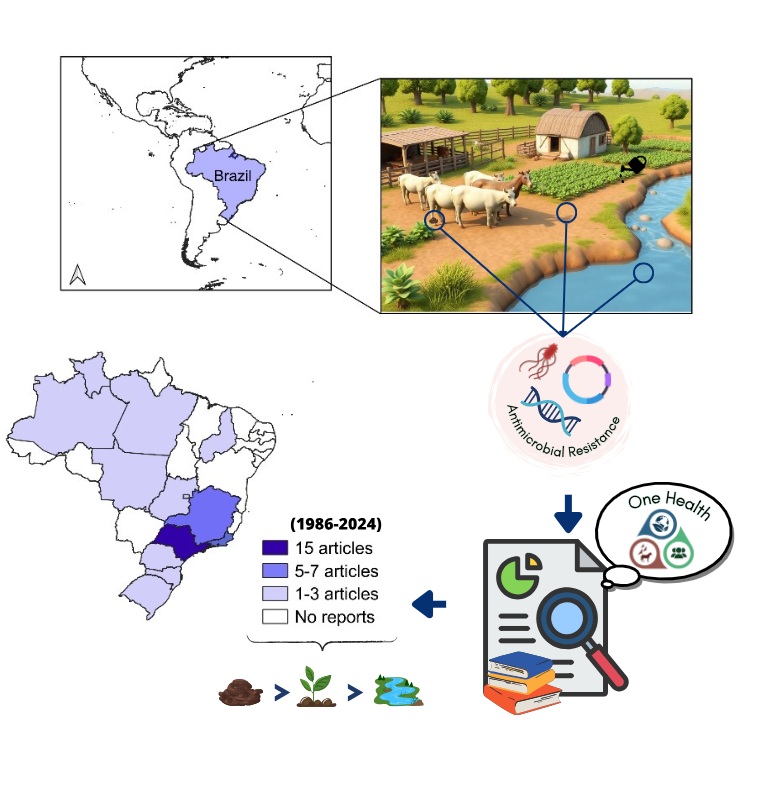Antimicrobial resistance in agricultural environments in Brazil – A concern from a One Health perspective
11/Jul/2025
ABSTRACT Antimicrobial resistance is a global public health concern that requires an integrated approach including human, animal and environmental health. Agricultural environments, such as soil, animal waste and irrigation water, play crucial roles in the dynamics of antimicrobial resistance, as they act as reservoirs and pathways for disseminating resistance determinants. However, these agricultural environments are still often underestimated or neglected in many studies. This study aimed to address antimicrobial resistance in agricultural environments in Brazil and summarize the current state […]
EFFECT OF WATER AVAILABILITY ON SOIL MICROBIAL BIOMASS IN SECONDARY FOREST IN EASTERN AMAZONIA
01/Mar/2015
Soil microbial biomass (SMB) plays an important role in nutrient cycling in agroecosystems, and is limited by several factors, such as soil water availability. This study assessed the effects of soil water availability on microbial biomass and its variation over time in the Latossolo Amarelo concrecionário of a secondary forest in eastern Amazonia. The fumigation-extraction method was used to estimate the soil microbial biomass carbon and nitrogen content (SMBC and SMBN). An adaptation of the fumigation-incubation method was used to […]
Development of jatropha seedlings under saline irrigation
01/Aug/2013
The use of saline irrigation water is an important alternative in view of the lack of good water quality throughout the world. The water requirement of jatropha (Jatropha curcas L.) is low, and the species survives and produces satisfactory yields in low-fertility soils. However, yields are higher in irrigated crops, indicating the need of studying the possibility of using saline irrigation water. This study aimed to evaluate the effect of different salinity levels of irrigation water on the morphological and […]
Influence of soil bulk density in a dystroferric red ultisol moisture estimated by time domain reflectometry
01/Oct/2011
Among the techniques for soil moisture evaluation, the use of Time Domain Reflectometry (TDR) stands out, which consists of an indirect, non-destructive, fast and accurate method less dependent on environmental factors. However, works carried out after its applications suggest the influence of factors related to soils structural and mineralogical characteristics, which makes necessary the site calibration for the TDR proper functioning. The aim of this work was to study the influence of bulk density (Ds) on the volumetric soil water […]
Water storage and muskmelon productivity of a drip-irrigated soil with and without soil cover
01/Oct/2010
In regions with water stress, irrigation methods that optimize water application to crops are required for agricultural production. Knowledge on soil water storage in the soil rooting zone during an agricultural crop cycle is essential for water and soil management. The objective of this study was to evaluate water storage in an Inceptisol under drip-irrigated muskmelon, with and without soil cover. The experiment was carried out in the Apodi Tableland, county of Baraúna, state of Rio Grande do Norte, Brazil […]
Plot-size for 15N-fertilizer recovery studies by tanzania-grass
01/Apr/2009
The understanding of the N dynamics in pasture ecosystems can be improved by studies using the 15N tracer technique. However, in these experiments it must be ensured that the lateral movement of the labeled fertilizer does not interfere with the results. In this study the plot-size requirements for 15N-fertilizer recovery experiments with irrigated Panicum maximum cv.Tanzania was determined. Three grazing intensities (light, moderate and intensive grazing) in the winter, spring and summer seasons were considered. A 1 m2 plot-size, with a […]
Least limiting water range of an irrigated dystroferric red nitosol
01/Apr/2009
The establishment of irrigation management has been based on the soil water potential (Ψ) as a limiting factor for plant growth. However, other variables can affect crop growth even when Ψ is not limiting. The least limiting water range (LLWR) is a concept of available water that take account the influence of aeration and soil resistance to penetration (SR) in addition to Ψ. The objective of this study was to quantify the LLWR in an irrigated Dystroferric Red Nitosol and […]
Mineral nutrition of eucalypt seedlings grown under different irrigation levels and substrates
01/Aug/2007
The objective of this work was to evaluate the effects of gross irrigation depths on the nutrient concentration of Eucalyptus grandis seedlings, produced in different substrates. The experiment was carried out in Camará – Mudas Florestais, in Ibaté, São Paulo, in a factorial 5 x 4, with five daily irrigation levels (6, 8, 10, 12 and 14 mm), applied three times a day (at 10 am, 13 pm and 16 pm), on four substrates (FB- coconut fiber; CPV- pine bark […]
The daily water consumption of a wheat culture using atmospheric and soil data
01/Feb/2007
The daily water consumption of a wheat culture was quantified on an Oxisoil using atmospheric and soil data measured automatically on an experimental farm in Ponta Grossa, Paraná, Brazil. The measurement period was August through December 2003. The rain contribution to soil moisture and the vertical upward movement of water within the soil were particularly emphasized. Our results show that in the evaluated period (a) wheat evapotranspiration amounted to 6.75 mm a day, to which upward water flux contributed with 62 %; […]
Soil organic carbon in sprinkler irrigation systems under no-till and conventional tillage
01/Oct/2006
The effect of irrigation on soil C stocks is a result of the balance between the effect of this practice on C input through crop residues and of C losses through microbial decomposition of soil organic matter (SOM). This study aimed at assessing the influence of sprinkler irrigation on SOM dynamics and on the total C stocks in a subtropical Acrisol under no-till (NT) and conventional tillage (CT) in a long-term experiment (8 years). Irrigation increased the C addition (about […]

